How to Hold a Champagne Glass Correctly
The way you hold a champagne glass might seem like a small detail, but it plays a significant role in how you experience the drink. From preserving the chill of the bubbly to preventing smudges that obscure the clarity of the liquid, proper handling contributes to the overall elegance and enjoyment of champagne. Beyond etiquette, it also impacts the aroma, temperature, and even the bubbles—elements that define a true champagne experience.
To hold a champagne glass correctly, the most elegant and functional method is to grip the stem—not the bowl. This technique prevents your body heat from warming the champagne and keeps the glass looking clean and clear. A proper grip not only preserves the drink’s flavor and bubbles but also reflects polished etiquette at any occasion.
Understanding how to hold a champagne glass correctly is about more than looking refined at a celebration. It’s rooted in purpose, shaped by centuries of winemaking tradition, and refined through sensory science. Whether you’re sipping at a wedding, pouring for guests, or enjoying a quiet toast at home, the way you grip the glass can elevate the moment while preserving the integrity of the drink itself.
How to Hold a Champagne Glass: Step-by-Step
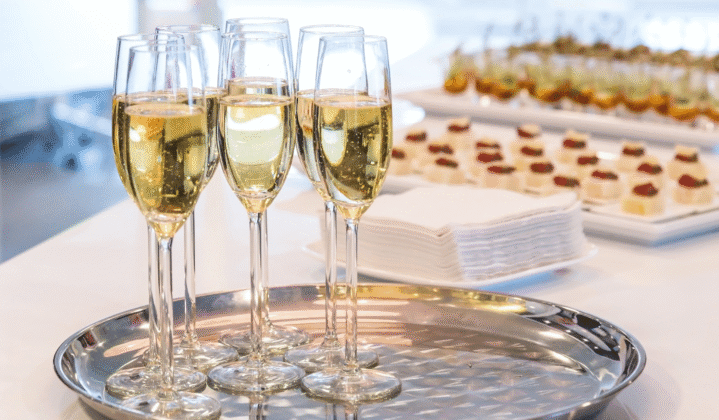
The following step-by-step approach applies across most stemmed glass styles and ensures both comfort and visual appeal.
1. Pinch the Stem Near the Bowl
Begin by gently pinching the stem of the champagne glass using your thumb and forefinger. Aim to position your fingers about half an inch below the point where the stem meets the bowl. This location provides optimal balance and control while reducing the likelihood of accidental tilting. Holding the stem too low can make the glass feel top-heavy, while holding it too high may risk warming the liquid.
2. Stabilize with the Remaining Fingers
Let your remaining fingers—middle, ring, and pinky—rest naturally along the stem or near the base. This added contact helps stabilize the glass without applying unnecessary pressure. Whether you’re standing, walking, or raising your glass for a toast, this hand placement creates a balanced, graceful hold that feels secure without appearing stiff.
3. Avoid Touching the Bowl
It might seem instinctive to grasp the bowl for security, especially with wider glasses like coupes, but doing so can compromise the drink. The warmth from your hands quickly raises the champagne’s temperature, flattening the bubbles and altering the taste. Additionally, touching the bowl leaves visible smudges and fingerprints, dulling the visual clarity that makes champagne so visually appealing.
4. Adjust Your Grip Based on Glass Type
While this method works best for flutes and tulip glasses—thanks to their longer stems and narrow bowls—it can be slightly modified for coupe glasses. Coupes have a shallower, wider design and shorter stems, which may feel less stable. In this case, you can support the underside of the bowl with your ring and pinky fingers, but your thumb and forefinger should still be the primary point of contact with the stem. The goal is to maintain elegance without compromising control or warmth.
How to Hold Different Champagne Glasses with Confidence

The way you hold a champagne glass depends not only on etiquette but also on the shape of the glass and the context in which you’re enjoying it. While the classic stem hold is the most refined and functional approach, there are subtle variations that allow for comfort, control, and elegance depending on the occasion and glassware.
Holding a Champagne Flute
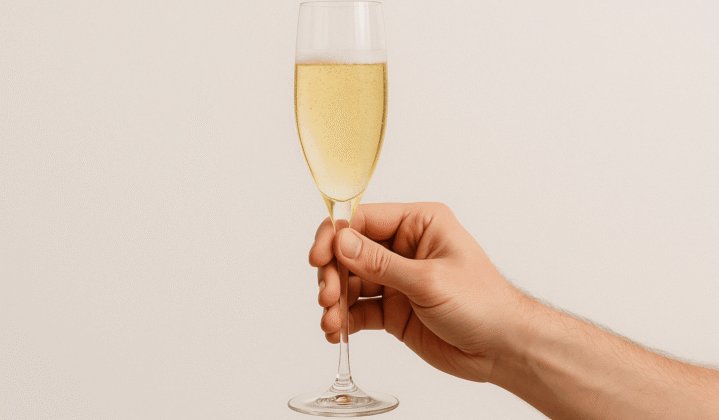
Flutes are designed to preserve bubbles and showcase the visual elegance of champagne. Always hold the glass by the stem to keep the liquid cool and the bowl free of smudges. Use a relaxed grip with the thumb and forefinger pinching the stem near the top, and let the remaining fingers stabilize the hold lower down. At formal events, maintain a neutral wrist position and keep the glass at chest or waist level when not sipping.
Holding a Champagne Tulip
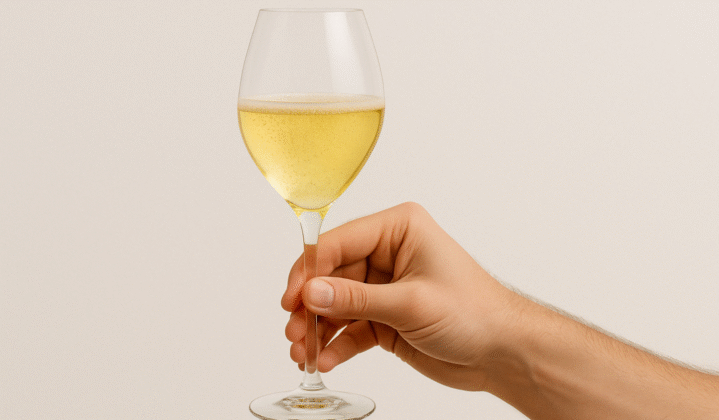
Tulip glasses offer a balance of bubble preservation and aromatic depth. Grip the stem just as you would a flute—lightly, yet securely—avoiding any contact with the bowl. Because the tulip’s bowl curves inward near the rim, tilting too steeply can cause spills. During a toast, it’s appropriate to raise the tulip glass by supporting the base with your other hand, always steering clear of holding the bowl itself.
Holding a Champagne Coupe
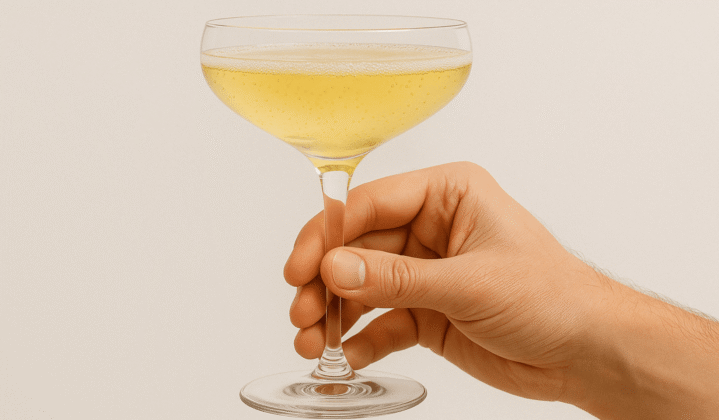
Coupes have a short stem and wide bowl, making them slightly more challenging to hold gracefully. The recommended technique is to pinch the stem with your thumb and forefinger while letting the ring and pinky fingers gently rest underneath the bowl for balance—without applying pressure or gripping. This prevents heat transfer and helps steady the glass during conversation or movement.
Acceptable Variations Based on Setting

1. Traditional Stem Hold (Recommended)
This is the standard across all types of champagne stemware. Pinch the stem with your thumb and forefinger near the top, allowing your middle finger to rest opposite for balance. Let your other fingers fall naturally toward the base. This method ensures temperature control and an elegant presentation.
2. Two-Finger Pinch
In casual settings, some may opt for a simpler hold using only the thumb and forefinger. This minimalist grip is still appropriate as long as it’s steady and close to the top of the stem. While it offers less control, it allows for relaxed sipping without compromising the champagne’s chill too quickly.
3. Palm Support Under the Base
When serving champagne or presenting it for a toast, it’s acceptable to support the base of the glass with your palm while guiding the stem with your fingers. This technique offers greater control when moving or offering the glass to someone else, especially in hospitality settings.
4. Modified Coupe Hold
Because of their shape, coupes often benefit from a tailored grip. Pinch the short stem with your thumb and forefinger, while your remaining fingers subtly support the base. This adds stability without warming the drink or smudging the bowl.
5. Rest-and-Sip Grip (Best Avoided)
Sometimes seen at casual gatherings, this method involves holding the bowl or its base with several fingers. While common, it is not ideal. This grip leads to rapid warming and visible smudges, making it a less desirable choice for any occasion where presentation or taste matters.
The Anatomy of a Champagne Glass

Stem
The stem is the most important part to engage with when holding the glass. It’s specifically designed to prevent your hand from warming the bowl. The length of the stem also allows you to gesture naturally while holding the glass without tipping or spilling. When holding champagne correctly, your fingers should grip the stem gently—typically with the thumb, index, and middle finger—while the base rests lightly above the palm.
Bowl
The bowl is where the champagne is poured, and its shape is essential for capturing the bouquet and maintaining the carbonation. A flute has a tall, narrow bowl that keeps bubbles rising in a tight stream. A tulip glass, which curves inward at the rim, helps concentrate the aroma and preserves effervescence. It’s important to avoid touching the bowl, as even brief contact can affect the temperature and leave unsightly smudges.
Base
The base provides stability when the glass is placed down and supports your grip when holding the glass with finesse. It’s not typically where one holds the glass, but for rare scenarios—like posing for a photo or placing it gently on a tray—it becomes relevant. The base should always remain clean and flat to prevent wobbling or tipping.
Why Champagne Glass Etiquette Matters
Holding a champagne glass correctly enhances both function and form. The traditional stemware used for champagne, like flutes, coupes, or tulips, is designed to support the wine’s structure and presentation. Touching the bowl of the glass warms the liquid, dulling its crispness and diminishing the subtle flavors and aromas that are best experienced when chilled. Moreover, fingerprints on the bowl can obscure visual clarity, which is particularly important when assessing champagne’s effervescence.
Beyond taste and temperature, etiquette reflects cultural norms. From formal receptions to corporate events, your posture, grip, and mannerisms while holding a glass speak volumes. It shows awareness, care, and an appreciation for the occasion. Much like holding a wine glass by the stem or swirling gently before a sniff, these customs are appreciated by sommeliers and casual enthusiasts alike.
Types of Champagne Glasses: Choosing the Right Stemware
Not all champagne glasses are created equal. Each design has its own purpose—some enhance aroma, others preserve bubbles, and a few simply prioritize style. Selecting the right stemware ensures you get the best tasting experience while matching the occasion.
Flute
The classic choice for champagne, the flute’s tall, slender bowl keeps carbonation concentrated and visually stunning. This shape minimizes oxygen exposure, which helps maintain effervescence. It’s ideal for standard champagne and sparkling wines that rely heavily on lively bubbles.
Tulip
Often favored by sommeliers, the tulip glass is slightly wider in the middle and tapers at the rim. This shape encourages aromatic development while still preserving bubbles, offering a more complex tasting experience. It’s especially well-suited for vintage champagnes or those with more nuanced flavors.
Coupe
Popular during the early 20th century and associated with vintage glamour, the coupe features a wide, shallow bowl. Though visually elegant, it allows bubbles to dissipate quickly due to its broad surface area. Coupes are often used for celebratory moments but are less preferred for preserving aroma and fizz.
Universal Wine Glass
Some opt for a standard white wine glass, especially when tasting higher-end champagnes. The broader bowl allows the wine to open up, which benefits vintage varieties with more depth. While it won’t retain bubbles as well as a flute or tulip, it supports flavor complexity and aroma appreciation.
Common Mistakes to Avoid
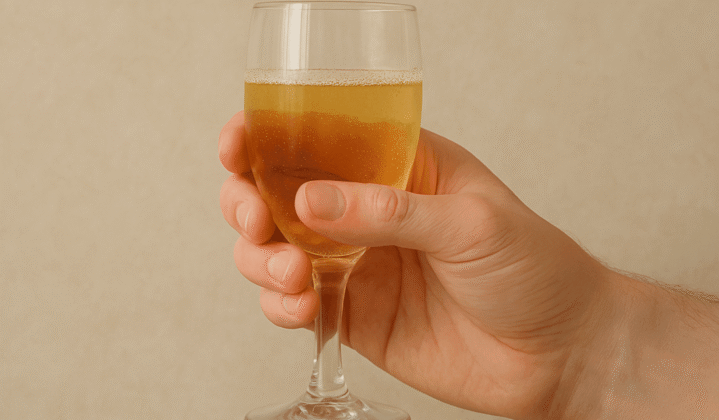
Gripping the Bowl
One of the most frequent mistakes is holding the champagne glass by the bowl. While this might feel more stable or intuitive for some, it introduces body heat that can warm the champagne and degrade its freshness. It also leads to visible fingerprints and may obscure the visual sparkle of the drink. Proper etiquette and sensory appreciation begin by respecting the function of the stem.
Holding Too Close to the Base
Some attempt to grip the stem very low, near the base, but this can make the glass feel top-heavy and unsteady. A grip closer to the middle of the stem ensures better balance and control. It also allows for a relaxed, comfortable hold during social gatherings.
Overfilling the Glass
Though it’s technically more of a pouring mistake, overfilling often leads to awkward grips or increased chances of spillage. When glasses are filled too high, it becomes tempting to hold them by the bowl to stabilize the weight. This defeats the purpose of proper technique. Pour only to about one-third full, which allows room for the champagne to breathe and reduces temperature transfer from your hand.
Holding Your Glass During a Toast
Toasting with champagne calls for composure and subtlety. When raising your glass, do so by the stem or gently support the base. Avoid clinking too forcefully—especially with delicate flutes or tulips—as it can cause cracks or spills. Maintain eye contact and a steady posture while delivering or receiving a toast. After the toast, lower your glass gracefully before taking a sip.
These small gestures contribute to the celebratory atmosphere and ensure that the drink remains enjoyable. In more refined settings, it’s considered polite to sip after the toast instead of during the clink itself.
Elevating Your Champagne Experience Through Proper Handling
Properly holding a champagne glass combines etiquette, science, and respect for tradition. From preserving temperature and aroma to showing awareness at formal occasions, these small details enhance every sip. It’s a subtle art that turns any pour into a polished experience.
Whether you’re enjoying a bottle of Dom Pérignon or marking a milestone with a dramatic sabrage, the way you hold the glass plays a role in shaping the entire experience. After the thrill of opening a bottle with a champagne saber, maintaining elegance in how you carry and sip from your glass completes the moment with refinement.
If you’re planning a celebration or simply want to enjoy your next glass with more intention, remember that how you hold the glass is part of the ritual. A confident, correct grip honors both the champagne and the occasion it represents.
